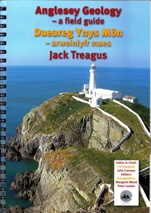 Anglesey Geology - A Field Guide
Anglesey Geology - A Field Guide
Jack Treagus
Published by: Seabury Salmon & Associates
Publication date: 2008
ISBN: 0 95469 662 X (pbk)
List price: £9.95 (£11.00 incl p&p)
168 pp
www.geomon.org.uk
How refreshing to have a beautifully presented guide to the geology of a classic British region that does not shy away from describing the geology in depth or drawing attention to the uncertainties that remain. Although an excellent adjunct for the armchair geologist, hopefully most readers will be inspired to visit the localities for themselves.
This is the first substantive account to be prepared for the recently established GeoMôn (Anglesey’s GeoPark). It is an educational book, aimed at colleges and universities; it is also suitable for interested amateurs. Jack Treagus knows Anglesey extremely well, and is familiar with many of the geological controversies. He succeeds in presenting a balanced view and, where appropriate, makes clear where other opinions might prevail. His book presents a total of 14 itineraries, each of which would take at least half a day. Many are coastal exposures, some of which are tide-dependant. With a paucity of good exposures inland, this means that it is unlikely that the whole set of itineraries could be fully studied within a week. Nevertheless, a little careful planning should enable the majority to be covered. Furthermore, the GeoMôn web site (www.geomon.org.uk/geosites) helpfully includes details of many additional sites, arranged according to geological age, as well as sources of information aimed at different educational levels.
The guide needs reading twice before use, first to get an overview of the breadth of coverage and second to appreciate the various nuances of detail for which each location is known. The stratigraphy provides an introductory framework but it is the structural deformation that makes Anglesey so special for a field study, together with its plate tectonic setting. The excellent images within the text help the reader identify key exposures. The colour photographs are very clear and well focussed. Furthermore, they are reproduced in clear detail, and so effectively enhance an understanding of the rock. In the field it would also be useful to have a text such as Ken McClay’s The Mapping of Geological Structures (last published in 1991 as part of the Geological Society’s Handbook Series), and a compass/clinometer (but not a hammer!).
Sufficient information is included to guide the visitor with respect to parking and access, but large scale topographic maps will also be essential. A number of localities are included for each itinerary, helping broaden one’s appreciation of the local geology and reduce concentration on the better known exposures. Printed on clay-rich paper to maximise the clarity of the photographic images, the book is perhaps a little heavy. However, the printers have sensibly selected a spring-type wire ring binding which can easily release those pages needed for a day’s excursion. For those less familiar with the scientific terminology, there is a useful seven-page glossary. The font is a little small but is clear, helped by the extensive use of colour, reduction of text block size by insertion of photographs, and dual columns to accommodate the Welsh text alongside the English.
The three-page reference list provides a good overview of the pertinent literature and will help facilitate further study. Perhaps the only omission is reference to one or two good books on structural geology, for instance: Price and Cosgrove’s Analysis of Geological Structures (1990) or Pollard & Fletcher’s Fundamentals of Structural Geology (2005).
This book is strongly recommended and good value for money!
Mike Rosenbaum, Ludlow